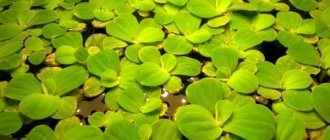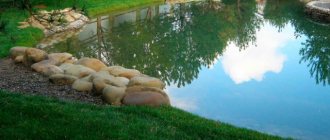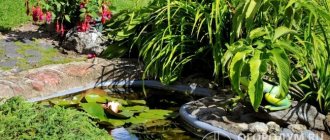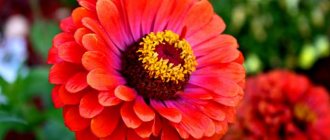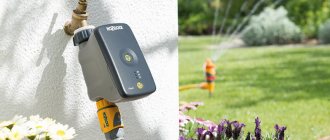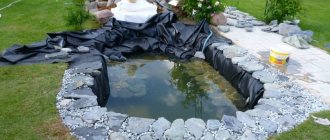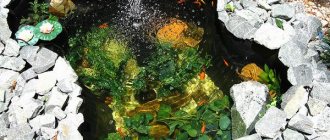In our catalog you will find only high-quality and modern products. It is sold at the best price, facilitated by direct connections with manufacturers.
A plastic bowl for a pond or stream is a great way to quickly create a comfortable and aesthetically pleasing pond with minimal effort. The finished form can be of any size, which makes it easy to fit into any area. Additionally, it can be decorated with lighting, fountains, a waterfall, or create a miniature mountain stream or a flower garden with aquatic plants.
Selecting a finished plastic bowl
When choosing a finished plastic bowl, you need to pay attention to the size, shape, color and material. For each specific landscape design, it is necessary to take into account all the nuances, because the wrong choice can lead to problems during installation and operation. Initially, you need to decide on the location of the pond and only then start searching.
To size
Often the shape of the container has irregular geometric shapes, so the system by which the dimensions are indicated is not the same as usual. The depth of the bowl ranges from 30 to 300 cm. If the pond is rectangular, then most often the depth is the same, but if it has several levels or is irregular in shape, then the depth is calculated based on the lowest part of the container.
Important! Typically, bowls have several levels with steps, cascades and recesses.
They are ideal for decoration with aquatic plants. Width and length are measured using the same principle. When specifying the size, the widest part is taken into account. Many landscape designers in their compositions use small structures of 250 liters, the size of which is 124x90x58 cm. With the help of such a small reservoir, you can equip even the smallest yard.
Shape and color
This landscape object is used exclusively as decoration. Of course, if you really want to, you can swim in it, and some owners even breed fish to imitate a more natural pond. The shape of a reservoir is often irregular, because a pond in its natural environment does not have clear geometric outlines.
Important ! The color of the container depends on the manufacturing company. However, most often they are black or other dark shades. It is worth considering that with the help of color, the natural environment is imitated.
But nevertheless, round, oval, square or rectangular shapes are used in garden design. With their help, they emphasize design in a style such as, for example, high-tech. But if we are talking about a summer cottage close to nature, then it is better to pay attention to bowls of irregular shapes, such as figure eights with various contours.
Choosing the right place for a pond
When choosing the ideal location for mounting a plastic container, there are many things to consider. In addition to the fact that the reservoir should be located in the most beautiful and attractive place, it should include the following key points:
- For a pond you should choose a plain. Hillocks and slopes will put pressure on the bowl, which will lead to deformation of the plastic structure.
- It is advisable that the soil be covered with turf.
- Avoid areas with trees. Foliage or needles will fall off and fall into the container. In addition, the roots will interfere with digging a hole to install the frame.
- Since the pond is the central element, it must be clearly visible from any point, so distant or hidden corners are not suitable for installation.
- The place should be partially isolated from sunlight. To prevent the water from blooming and evaporating, it is recommended to select an area that is illuminated no more than 6 hours a day.
- Also, when choosing a location, the size of the structure is taken into account.
Materials used
Waterproofing materials that will be needed for arranging a reservoir can be as follows:
Pond film is an elastic material suitable for universal projects. Butyl rubber is the most durable of the films and has different thicknesses, depending on the depth of the future pond. For a shallow reservoir up to 1 meter, 0.8 mm is enough, and for deeper ones from 1.5 mm. Polyethylene is a cheaper type, but it is not durable either. Possible deformations that can be eliminated with self-adhesive tape. Polyvinyl chloride is usually black and can be repaired with glue if it breaks.
Film is one of the simplest options for creating a pond. Source pinterest.com
Plastic – for small ponds (5-6 sq.m.), plastic containers are quite appropriate. They are easy to install, and their service life is up to several decades.
Pond with a base made of a plastic containerSource pro-remont.org
Concrete pit - when choosing a large pond with straight geometry. Here you will need to fill the walls and transitions between the terraces.
Concrete pouring - for medium and large pondsSource landshaftdizajn.ru
You can use any waterproof material, including roofing felt, or a reliable sealant - polyurea.
How to install and dig a decorative pond
Small plastic structures are quite easy to install. But if it comes to large containers, then you will have to involve technology.
Did you know? Even in ancient Egypt, people learned to build artificial ponds for their own needs.
Prepare the hole in the following way:
- turn the container upside down and draw a contour around it;
- approximately another 10 cm must be added to the main line;
- you need to dig a pit 15 cm larger than the plastic bowl itself;
- level the bottom of the pit as much as possible;
- fill empty spaces with sand and earth.
Since the bowl is not heavy, it can be easily transported and dug in by yourself. During installation in the pit, you need to carefully check that there are no distortions anywhere. When filling excess space with sand and soil, it is advisable to add water little by little and try to compact it as tightly as possible.
Important! Film should not be placed on the bottom of plastic bowls. This will not so much help in sealing as it will increase the formation of vapors, which will lead to damage to the pond.
If the bowl is large, then you should not rush to compact it, since wet sand can warp the container, and as a result it will break. The mixture should be poured gradually and in small parts, only then filled with water. Immediately after the water is absorbed, add a little more sand and soil and repeat the process until the very end. In addition, it is also important to add water to the pond to maintain balance. Each time there should be 10 cm more than the sand outside.
Video: Installing a decorative pond
Decorating the object
Installing plastic ponds is not particularly difficult. First of all, it is necessary to place the plastic pond in a ready-made trench and make sure that it stands level and without distortions. It is best to check the levelness of the installation using a building level. As a rule, when pouring a concrete base, the problem of skewing does not arise, but if the bottom was formed using a sand cushion, slight slopes are possible.
Next, you need to very carefully and evenly pour the soil into the cavity between the edges of the trenches and the plastic container. Before filling the soil, it is necessary to fill the plastic pond with at least 40 cm of water. The soil should be thoroughly compacted. As a rule, it is not possible to immediately compact the soil to the required extent, so as it subsides along the edges, you will have to fill it up. You can water the compacted soil several times.
After installing the plastic base of the pond, you need to think about decorating it. The following can be used as decorative elements:
- multi-colored tracing paper of different sizes;
- algae of different shapes and sizes;
- flat cobblestones for decorating the bottom;
- rounded cobblestones for the coastline.
Among other things, you can, if desired, use flagstone to decorate the shoreline of the future pond. Before immediately starting work on arranging the future pond, you should pump out all the water that is present in it. Among other things, you need to think about additional equipment. If you plan to keep fish or other living creatures in the pond, it would be a good idea to install equipment to saturate the water with oxygen. It is worth noting that some aquatic plants are also sensitive to the level of oxygen saturation in the water.
Among other things, if you plan to install decorative fountains or make a waterfall, you should also purchase the necessary equipment. Around the pond you can build an alpine slide or plant various plants that love moisture. The arrangement of the pond should begin by laying flat stones on the bottom and all horizontal bends of the plastic container. To cover the black sides, you can use both stable flat stones and rounded cobblestones, among which you should place containers with soil and aquatic plants planted in them. When selecting elements for decorating an artificial pond, you should try to make the pond as similar as possible to the real one.
How to decorate beautifully
To make your pond look as natural as possible, like in nature, opt for blanks of irregular geometric shapes with pockets and cascades. Thanks to this, the pond can be decorated with aquatic plants and stones. Vegetation with different flowering periods will decorate the pond all season, which, in turn, will make it very attractive right up to the onset of cold weather.
Find out also about creating a decorative pond from plastic film.
landscaping
When landscaping a small or large plastic bowl frame, try not to overdo it. In this case, when decorating, it is important to pay more attention to terrestrial plants than to aquatic ones. The fact is that aquatic ones most often do not take root due to frosts or, on the contrary, grow at a rapid speed, filling all the free space, covering the water. In addition, duckweed is formed from some floating plants, which also hides the water area.
When choosing coastal plants, study their natural environment; it is important that they are moisture-loving. This type of plant guarantees long-term growth and a beautiful appearance for your summer cottage. It is worth noting that it is not recommended to plant large lush or tall plants. In the fall, leaves will fall, making it more difficult to clean the water.
Pay attention to the information about the construction of a pond for fish breeding and swimming.
Decor
To create a beautiful pond, landscape designers recommend using natural materials such as stone. In nature there is a huge variety of stones of different sizes, colors, and structures. For example, sandstone has a warm tone and is ideal for naturalistic landscapes. If you want to add some modernity, then use slate and flagstone.
Cool grey, green and brown shades will not draw attention to themselves. In order, on the contrary, to pay as much attention as possible to the decor, then decorate the shore with the help of coil boulders. But in this case, a small pond may simply get lost against the background of the stone. To define the edges, use gravel around the entire perimeter. It will not only emphasize the shape of the pond, but will also draw attention to the color scheme and texture of nearby flowers and shrubs.
You may be interested in information about the equipment of a clay pond on the site.
Briefly about the main thing
A small pond in a country house can perform a wide range of functions, including fish breeding, a place for swimming, relaxation, and decorating the local area.
But it is important to take into account that a reservoir can be used to solve several problems only if the work on its arrangement was carried out in accordance with the above norms and rules. It is necessary to use high quality materials and observe technological aspects that will help prevent shedding, silting or contamination of the reservoir.
Ratings 0
Rules of care and use
The plastic construction is also attractive because in winter there is no need to drain the water. Modern materials can withstand low temperatures. This type of bowl can withstand frosts down to -30°C. In addition, deep troughs in mid-latitudes do not freeze at all.
Care consists of the following:
- Sometimes you need to clean off duckweed, algae or silt. This is done without draining the water. But in case of severe contamination, it is recommended to drain the water using a pump, thoroughly clean the container and fill with fresh, clean water.
- To prevent water from stagnating or blooming, install a small pump and filter that will ensure circulation.
- Leaves, branches or petals from trees or bushes can fall into the pond. They need to be cleaned as often as possible. In the fall, it is better to completely cover the structure with a net.
Did you know? In China, river and lake fish are grown in artificial ponds, since there are very few of them left in natural conditions. The most popular is the koi carp.
Since the plastic form is quite frost-resistant, it does not need to be dismantled and hidden in a warm place for the winter. It can withstand down to -30°C. In most cases, there is no need to drain the water, but in colder climates it is better to do this or, as experts recommend, pour sand into plastic bottles and place it in a container. When water freezes, it expands, and sand can slightly prevent a lot of pressure on the walls of the mold and take some of this pressure onto itself.
Preparing the fish
Any movement causes stress, so it is better to leave the inhabitants in the pond. The exception is heat-loving fish, which must be removed. No fish should be left in small ponds.
At this stage, remember the following:
- Before wintering, feed food with a high protein content. Then the fish will gain the necessary nutrients and live the whole winter without feeding. Use universal formulations, since it is still impossible to feed different species separately.
- Ideally, install an aerator; with its help, the water will always be saturated with oxygen. If this is not possible, then make an ice hole and constantly clean it so that air flows in and the inhabitants do not suffocate. Don't make the wormwood too big. You can pour hot water into it to heat it up.
- In regions with warm winters, it is possible to install a special heater in the pond. With it, the ice may not cover the water. But such equipment is not designed for very low temperatures, so it should not be used in the middle zone and colder regions.
- If it is necessary to remove the inhabitants from the reservoir, then prepare an aquarium or other container in advance. Select the size in such a way that for each fish no more than 10 cm long there is a bucket of water; for large specimens the norm is even higher. Place in a room with a temperature of at least 15 degrees with moderate lighting.
- Be sure to install an aerator and a water purification system, then you won’t have to change it every month. Monitor the condition of the inhabitants, in case of severe contamination, replace at least part of the fluid and install more powerful equipment.
Advice! In winter, fish need not only oxygen, but also lighting. Therefore, the surface of the ice must be cleared of snow at least partially, there must be gaps.
Advantages and disadvantages of a garden pond made of HDPE
A self-made pond will decorate any garden plot. But, like everything in this world, a garden pond made of HDPE also has its pros and cons.
- Disadvantages include:
- it is impossible to change the shape;
- high exposure to sunlight will cause cracks to appear;
- complex elimination of mechanical damage;
- the shallow depth does not allow nymphs and fish to overwinter;
- not durable;
- It is almost impossible to make a pond as natural as in nature.
- The main advantages include:
- ease of installation;
- affordable price;
- a large assortment;
- good conditions for aquatic and coastal plants;
- frost resistance;
- doesn't rot.
Artificial ponds are an excellent solution for decorating a garden. Decorated with greenery, stones and other decorative elements, the pond will become the center of attention. And the fish swimming inside will not leave anyone indifferent. Lightweight, affordable and practical containers of various shapes and sizes will change the area beyond recognition. Thanks to their unpretentiousness and proper care, they will last for many years, delighting owners and guests.

